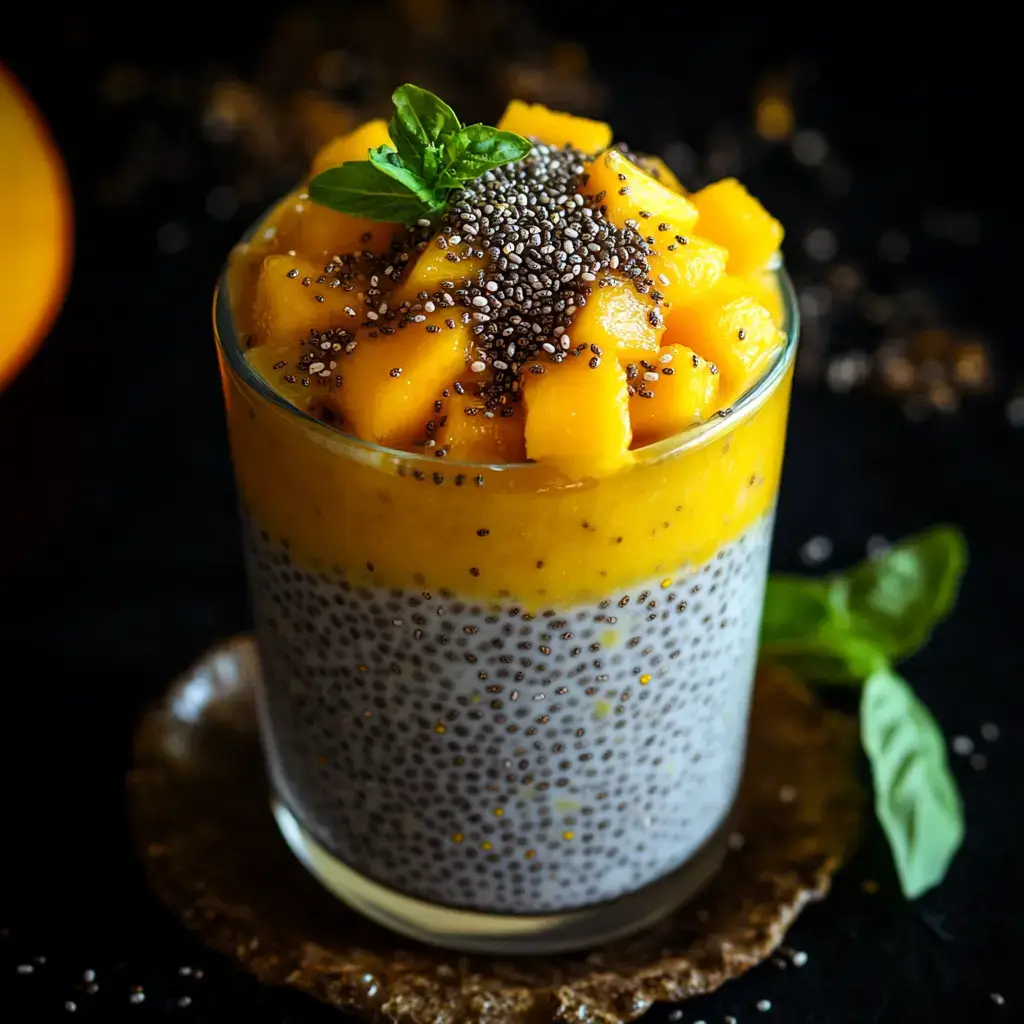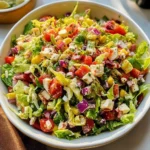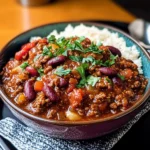Introduction
Chia seed pudding with mango is a delightful, nutrient-rich dessert that has taken the culinary world by storm. This delicious blend of creamy chia seeds, sweet almond milk, and juicy mango offers a perfect balance of flavors and textures. Not only is this pudding incredibly tasty, but it’s also packed with health benefits, making it a popular choice among health enthusiasts and foodies alike. Whether you’re looking for a quick breakfast, a satisfying snack, or a guilt-free dessert, chia seed pudding with mango is a versatile dish that fits the bill. In this article, we will explore the ingredients, detailed preparation instructions, nutritional benefits, serving suggestions, and much more to help you make the perfect chia seed pudding with mango.
Ingredients
To make this delicious chia seed pudding with mango, you’ll need the following ingredients:
- 1/2 cup chia seeds
- 2 cups almond milk (or any plant-based milk)
- 1-2 tbsp maple syrup (or honey)
- 1 ripe mango, diced
These simple ingredients come together to create a creamy, flavorful pudding that’s both satisfying and nutritious.
Instructions
Making chia seed pudding with mango is a straightforward process. Follow these steps to create this delightful dish:
- Combine Ingredients:
In a bowl, mix chia seeds, almond milk, and maple syrup. Ensure that the chia seeds are well incorporated into the almond milk to avoid clumping. - Initial Resting:
Stir well to combine and let sit for 10 minutes. This resting period allows the chia seeds to begin absorbing the liquid and expand. - Stir Again:
Stir the mixture again to avoid clumps. Giving it another stir ensures a smooth, even consistency throughout. - Refrigerate:
Refrigerate for at least 2 hours or overnight. Letting the pudding chill allows it to thicken and develop a creamy texture. - Serve:
Serve chilled, topped with diced mango. The fresh mango adds a burst of tropical sweetness and complements the creamy pudding perfectly.
Nutrition Facts
Chia seed pudding with mango is not just delicious but also comes with an impressive nutritional profile. Here’s what you can expect per serving:
- Calories: 200
- Protein: 5g
- Carbs: 30g
- Fats: 9g
- Fiber: 10g
Packed with fiber, protein, and healthy fats, this pudding is a wholesome treat that can help keep you full and satisfied.
How to Serve
Chia seed pudding with mango is not only a nutritious treat but also a versatile dish that can be enjoyed in various ways. Whether you’re looking for a delicious breakfast, a quick snack, a sophisticated dessert, or a visually stunning parfait, this pudding can be tailored to suit your preferences and occasions. Here are some detailed serving suggestions to help you enjoy this delightful dish to the fullest:
As a Breakfast Bowl
Starting your day with chia seed pudding can be both fulfilling and energizing. To transform it into a breakfast bowl, consider the following enhancements:
- Toppings: Elevate your pudding with a variety of toppings. Crunchy granola adds texture, while nuts such as almonds, walnuts, or pecans provide healthy fats and protein. Fresh fruits like berries (strawberries, blueberries, raspberries) or banana slices introduce natural sweetness and additional vitamins, making your breakfast even more nutritious.
- Drizzle: A drizzle of honey, maple syrup, or agave nectar can enhance the sweetness, depending on your taste preference. For a tropical twist, consider adding a splash of coconut milk or a sprinkle of cinnamon.
- Serving Tip: Serve in a large bowl or a mason jar for a rustic touch. The beauty of the mango pudding and toppings creates an inviting visual appeal that can make breakfast feel special.
As a Snack
Chia seed pudding is an excellent option for a mid-day snack, providing sustained energy without the heaviness of traditional snacks. Here’s how to enjoy it:
- On Its Own: Simply grab a pre-portioned cup of chia seed pudding for a quick, nutritious snack that’s high in fiber and omega-3 fatty acids. The pudding’s creamy texture makes it satisfying without feeling overly indulgent.
- Add-In Options: If desired, you can mix in a spoonful of nut butter (like almond or peanut butter) for added protein and richness. Alternatively, sprinkle some seeds or dried fruits for a bit of chewiness and flavor.
- Presentation: Serve it in a small bowl or jar, garnished with a mint leaf to add a touch of freshness. This simple presentation elevates the experience, making it feel more intentional.
As a Dessert
Chia seed pudding can easily transition into a sophisticated dessert, perfect for impressing guests or treating yourself. Here’s how to serve it elegantly:
- Elegant Glasses: Use clear dessert glasses or small trifle dishes to showcase the beautiful layers of mango pudding. This not only looks stunning but also allows guests to see the vibrant colors of the pudding and any layers you may add.
- Toppings: Top each serving with a dollop of velvety coconut cream or whipped cream for creaminess. A sprinkle of toasted coconut flakes adds a delightful crunch and enhances the tropical flavor. For an extra touch, consider adding a few edible flowers or a sprig of mint for garnish.
- Flavor Variations: Experiment with flavors by incorporating spices such as cardamom or vanilla bean into the pudding before serving. This creates a more complex flavor profile that can elevate the dessert experience.
Layered Parfait
Creating a layered parfait with chia seed pudding is not only visually stunning but also allows for a delightful mix of textures and flavors. Here’s how to build a beautiful parfait:
- Layering: Begin by spooning a layer of chia seed pudding into a tall glass, followed by a layer of your favorite yogurt (Greek yogurt works well for added protein). Then, add a layer of additional fruits, such as sliced kiwi, berries, or even a layer of diced mango for a double mango treat.
- Repeat: Continue layering until the glass is full, finishing with a layer of chia pudding on top. This not only creates a beautiful presentation but also ensures a balance of flavors in every bite.
- Final Touches: Top the parfait with crunchy granola or nuts for an added crunch and a drizzle of honey or a sprinkle of chia seeds for decoration. Serve with a long spoon to enjoy the delightful mix of textures as you dig in.
- Occasions: Layered parfaits can be served at brunches, as a light dessert for dinner parties, or even at picnics, making them a versatile option for various occasions.
By incorporating these serving suggestions, you can fully enjoy the delightful versatility of chia seed pudding with mango, whether it’s a refreshing breakfast, a nutritious snack, a stunning dessert, or an elegant parfait. Each serving method allows you to customize the flavors and textures to suit any occasion or preference, making this dish a staple in your culinary repertoire.
Additional Tips
To elevate your chia seed pudding experience with mango, consider the following comprehensive tips that cater to various preferences and enhance the overall enjoyment of the dish.
Adjusting Sweetness
One of the most delightful aspects of chia seed pudding is its versatility in sweetness. When preparing your pudding, the sweetness can significantly influence the overall flavor profile. Here are some detailed suggestions on how to achieve your desired level of sweetness:
- Natural Sweeteners: While maple syrup and honey are popular choices, you might also explore alternatives like agave nectar, coconut nectar, or even stevia if you prefer a low-calorie option. Each sweetener brings a unique flavor, so try a few to find your favorite.
- Taste Testing: Start with a smaller amount of sweetener than the recipe calls for. After mixing, taste the pudding and gradually add more sweetener until it reaches your preferred level of sweetness. This method ensures you can adjust according to your taste without overwhelming the natural flavors of the mango and chia.
- Fruit Sweetness: Consider the sweetness of the mango itself. If you’re using particularly ripe mangoes, you might find that you need less added sweetener. Alternatively, if your mangoes are less sweet, you might need to enhance the pudding with a bit more syrup or honey.
Texture Preferences
The texture of your chia pudding can greatly affect your eating experience. Here are some tips on how to customize the consistency to suit your preferences:
- Blending for Creaminess: If you prefer a smoother, creamier texture, consider blending the chia pudding before refrigerating. Use a high-speed blender to mix the soaked chia seeds with your chosen liquid (like almond milk or coconut milk) until smooth. This method breaks down the seeds and creates a more uniform pudding.
- Layering Textures: For those who enjoy a bit of variety, consider creating a layered texture. Start with a base of blended chia pudding and then add whole chia seeds or chunks of mango on top. This not only adds visual appeal but also creates a delightful contrast in texture.
- Soaking Time: The longer you allow the chia seeds to soak, the thicker the pudding will become. If you prefer a thicker pudding, let it sit for at least 4 hours or overnight. For a thinner consistency, you can reduce the soaking time.
Mango Varieties
Mangoes are not only delicious but also come in a variety of flavors and textures. Experimenting with different varieties can enhance your pudding. Here’s how to make the most of your mango selection:
- Popular Varieties: Some of the most flavorful mango varieties include:
- Ataulfo (Honey Mango): Known for its creamy texture and sweet flavor, it’s perfect for adding a rich sweetness to your pudding.
- Haden: This variety is both sweet and slightly tangy, adding complexity to the flavor profile of your pudding.
- Kent: With its smooth texture and sweetness, Kent mangoes are great for blending into a pudding.
- Tommy Atkins: While not as sweet as some other varieties, Tommy Atkins mangoes are widely available and can still add a refreshing flavor.
- Ripeness Matters: Choose ripe mangoes for the best flavor. A ripe mango will yield slightly to pressure and have a sweet aroma. If your mangoes are under-ripe, consider letting them sit at room temperature for a few days until they ripen.
- Combining Flavors: Don’t hesitate to mix different varieties of mango in your pudding to create a unique flavor combination. This can lead to a more complex and enjoyable taste experience.
Storage
Proper storage of your chia seed pudding is essential to maintain its freshness and flavor. Here’s how to keep your leftovers at their best:
- Airtight Containers: Use glass or BPA-free plastic airtight containers to store your pudding. This helps prevent any absorption of odors from the refrigerator and keeps your pudding fresh.
- Shelf Life: Your chia seed pudding can be stored in the refrigerator for up to 5 days. However, for the best taste and texture, it’s recommended to consume it within the first 3 days.
- Serving Suggestions: When ready to enjoy your stored pudding, give it a good stir as the chia seeds may settle at the bottom. You can also add a splash of milk or a bit of fresh mango on top before serving to refresh its flavor and texture.
By implementing these additional tips, you can customize your chia seed pudding with mango to suit your taste, enhance its texture, and explore the delightful world of mango varieties, all while ensuring your leftovers stay fresh and delicious!
FAQs
1. Can I use regular milk instead of almond milk?
Yes, you can substitute almond milk with any milk of your choice, including cow’s milk or other plant-based alternatives like soy or coconut milk.
2. How can I make the pudding thicker?
If you prefer a thicker pudding, reduce the amount of almond milk or add more chia seeds. Allowing it to chill overnight also helps achieve a thicker consistency.
3. Is chia seed pudding gluten-free?
Yes, chia seed pudding is naturally gluten-free, making it a suitable option for those with gluten sensitivities.
4. Can I add other flavors to the pudding?
Absolutely! Feel free to mix in vanilla extract, cinnamon, or nutmeg to enhance the flavor profile of your pudding.
5. What if I don’t have fresh mango?
If fresh mango is not available, you can use frozen mango chunks. Just thaw them before adding to the pudding.
Conclusion
Chia seed pudding with mango is a delightful culinary creation that combines taste, nutrition, and simplicity in one delectable dish. Whether you’re new to chia seeds or a seasoned fan, this pudding offers a refreshing way to enjoy their many benefits. By following the guidelines in this article, you can easily prepare a delicious and nutritious treat that will impress your taste buds and support your health goals. Enjoy experimenting with different flavors and serving styles to make this recipe your own. Chia seed pudding with mango is not just a dessert; it’s a celebration of wholesome, vibrant ingredients that nourish the body and soul.
Print
Chia Seed Pudding with Mango
Ingredients
To make this delicious chia seed pudding with mango, you’ll need the following ingredients:
- 1/2 cup chia seeds
- 2 cups almond milk (or any plant-based milk)
- 1–2 tbsp maple syrup (or honey)
- 1 ripe mango, diced
Instructions
Making chia seed pudding with mango is a straightforward process. Follow these steps to create this delightful dish:
- Combine Ingredients:
In a bowl, mix chia seeds, almond milk, and maple syrup. Ensure that the chia seeds are well incorporated into the almond milk to avoid clumping. - Initial Resting:
Stir well to combine and let sit for 10 minutes. This resting period allows the chia seeds to begin absorbing the liquid and expand. - Stir Again:
Stir the mixture again to avoid clumps. Giving it another stir ensures a smooth, even consistency throughout. - Refrigerate:
Refrigerate for at least 2 hours or overnight. Letting the pudding chill allows it to thicken and develop a creamy texture. - Serve:
Serve chilled, topped with diced mango. The fresh mango adds a burst of tropical sweetness and complements the creamy pudding perfectly.
Nutrition
- Serving Size: one normal portion
- Calories: 200
- Fat: 9g
- Carbohydrates: 30g
- Fiber: 10g
- Protein: 5g





